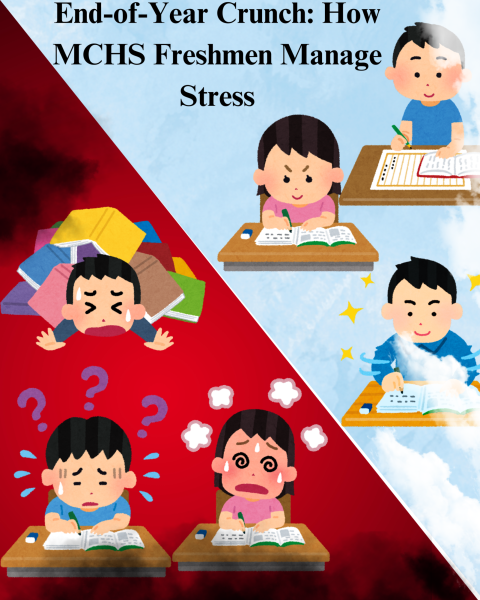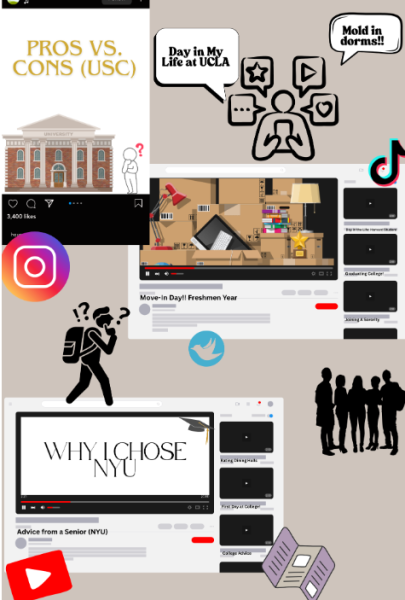Should you compare yourself to a supermodel? Social media contributes to adolescents’ perceived flaws
Leslie Portillo (created with Canva)
Social media has a negative impact on children’s and adolescents’ self-image.
With 7.6 billion people on earth and a short handful of social media platforms, opinions and standards related to one’s appearance and beauty come from a narrow focus of beliefs which may lead to a pessimistic view of yourself.
Advertisements and social media platforms are ubiquitous. Technology is one of the fastest growing industries in the world. People have easy access to social media. As adults, it is easy to distinguish between right and wrong. For youngsters, it is a different story.
While growing up, I was always insidious to myself. I compared myself to other people. I was always a fat child; most of the time, my classmates were skinnier than me. I would always stare at them while they were walking down and wondering why I could not be as skinny as them. This eventually led to me restricting myself from certain foods and working out until I ran out of breath. I eventually started worrying how others would see me instead of making precious memories.
When I was a child with no access to technology, just viewing other kids caused me to think negatively of myself. Children these days may have it even worse. I experienced this with my own eyes with one of my youngest sisters. She came up to me and stated that she would eat less bread and more vegetables. In addition, she stated that she needed to run more and do more jumping jacks to not be fat anymore. As the oldest sister, I was worried and concerned about her sudden change in behavior as it is not normal for a 6-year-old to be thinking like this. So I asked my mom about this sudden change in behavior and stated how each time my sister encountered someone while walking outside, she would suck in air from her stomach to appear skinny. Later on, she would check if anybody was nearby; if there was no one then she would let out her breath and continue to walk regularly.
Children thinking like this at such a young age is pernicious. Kids should focus on making memories and not on how they look. Girls Empowerment Network helps corroborate information on how females get influenced by the media on beauty standards. In 2015, Laura Romo convened a focus group featuring Mexican American adolescent females to evaluate their perceptions on body image and media. Most girls said they accepted that being thinner is the definition of perfection as seen by white women in film, TV shows, commercials, and so on. And while many of them respected some of the curvier bodies in the media (some included Beyoncé and Selena), they often just feel such a need to embody the mainstream expectation of being slim.
A senior student from Middle College High shared her journey on accepting herself for what she truly is.
“One of the first remarks I remember being made was that my teeth were funny looking and very big. But my older brother just happened to be there and made me feel a lot better so I didn’t care for the comment as much in the moment.”
Having someone with you to go through this phase helps a lot in feeling reassured about yourself. Furthermore, having friends and family will help you cope. The feeling that you have experienced, however, will always linger and come back once in a while.
“When I remembered the comment, I looked at myself in the mirror and thought ‘Wow, I do have pretty funny looking teeth but I wonder what else people think is funny looking that I haven’t noticed before,’” she said.
She eventually started to learn how to love herself and be more confident.
Counselor Velina Espinosa shared out her thoughts, many of which we need to take within ourselves.
“There is always a phase where you are compared to media images so I think the media are doing a better job more recently of showing different types of people and body types. Not just the thin models but more people that look more normal. If you compare yourself to the media out there it is challenging because no one is going to live up to that. A way to maintain an image like that you must not be eating nothing at all. Most models are thinner than usual.”
This elucidates that wanting to look like the people portrayed in the media is unhealthy.
“Even if the celebrities or models shown are aesthetically pleasing, you need to think if their condition is actually attainable. Most of these people that are shown to the public are usually in their prime stage,” stated Espinosa.
Once someone has gone too far and restricted themselves on one certain food for their diet, it is no longer a diet. Espinosa makes a good statement that it is more of a limit on pushing yourself on how much you can really survive with through the whole day. People have forgotten what a true diet looks like. A true diet is with proper proportions of dairy, proteins, whole grains, fruits, and vegetables.
If people keep comparing themselves with another person, we may as well be a group of Barbies that are standing on a shelf and waiting to be sold. Since most of these dolls are replicas of one another, none of them really stand out. Therefore, it is better to be taken off that shelf. You should strive less to appeal to others and instead try to focus on standing out in your own unique way. Because, once these dolls go out of fashion, they will ultimately be replaced.
Reflecting to my childhood in elementary and middle school years, I really regret how I spent it. Most of my memories were really just trying to satisfy everyone around me while I tried to lose weight in order to appear attractive in jeans. I am infuriated at how most of my memories are just me comparing myself with someone else.
Please show awareness of beauty expectations and support body positivity so that other people won’t regret their memories of childhood as well.
My favorite animal is a bear, I love making friendship bracelets, and my favorite player for Valorant is Sage.





































